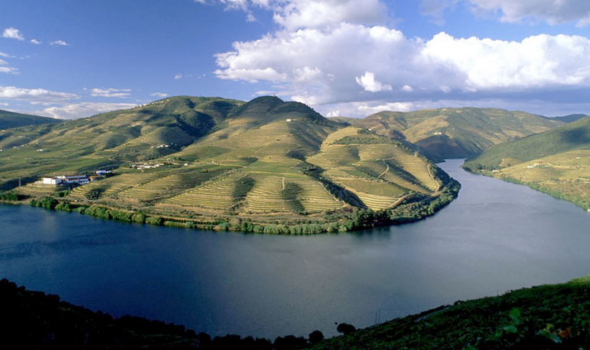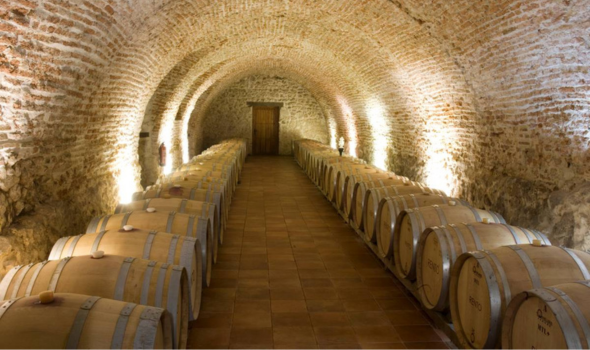
Ordenar per:
The D.O. Ribera del Duero is a prestigious wine region located in the north of Spain, in the autonomous community of Castilla y León. It is one of the most recognized and valued denominations both nationally and internationally.

The elaboration of the red wines of the Denomination of Origin (D.O.) Ribera del Duero follows a careful and meticulous process to ensure the quality and distinctive characteristics that make them so appreciated. The grapes are harvested manually or with specialized machinery at the optimum moment of ripeness. Choosing the timing of the harvest is crucial to obtain grapes with the right balance of sugar, acidity, and tannins. The grapes are destemmed, that is, they are separated from the bunch, and then gently squeezed to release the juice without breaking the seeds, which could contribute bitter tannins. The crushed grapes and their juice (must) are placed in fermentation tanks, where natural or added yeasts convert the sugar in the must into alcohol. During this process, colors and flavors are extracted from the skins of the grapes, giving rise to the characteristic color of red wines. After fermentation, the must, and solids (pulp and skins) are allowed to sit together for additional time to extract more compounds and tannins from the skins, contributing to the wine's structure and complexity. After maceration, the young wine is separated from the solids, a process called "discovering". The solids are gently pressed to extract the remaining liquid and added to the young wine fraction. Some wines go through malolactic fermentation, in which malic acid is converted to lactic acid, softening the acidity of the wine, and adding a silkier texture.
Many Ribera del Duero red wines undergo a period of aging in oak barrels, giving them additional flavors and allowing them to develop greater complexity and elegance. Aging can vary in duration, from a few months to several years, depending on the style of wine desired. After aging, the wines can be blended to obtain a consistent profile before being bottled and labeled as D.O. Ribera del Duero. It is important to note that the details of the production process can vary between different wineries and specific wines, and the choice of techniques can influence the style and character of the final wine. Winemakers play a pivotal role in this process, using their experience and knowledge to create high-quality, expressive wines that reflect the region's terroir.

In the D.O. Ribera del Duero, the dominant and characteristic red grape variety is Tinta del País, also known as Tempranillo. This grape represents most of the red wine production in the region and is responsible for the emblematic wines of Ribera del Duero. In addition to Tinta del País, other red grape varieties are also allowed to a lesser extent, such as Cabernet Sauvignon and Merlot, which are used to complement and enrich the wines along with Tempranillo. These secondary varieties provide structure, additional notes, and greater complexity to the wines of the region, although always under the prominent presence of Tempranillo as the heart of the Ribera del Duero red wines.
The red wines of the D.O. Ribera del Duero are perfect to pair with a wide variety of dishes, thanks to their rich structure and aromatic complexity. Some classic options to accompany these wines include grilled red meats, roast lamb, suckling pig, Iberian sausages, and cured cheeses. They also harmonize very well with game dishes, such as venison or wild boar. In addition, its elegant acidity and soft tannins make it an excellent choice to accompany stews, stews, and Mediterranean dishes. In summary, Ribera del Duero red wines are versatile and perfectly complement a variety of dishes, providing a memorable gastronomic experience.
 Wine Shop
Wine Shop
 Red Wine
Red Wine
 Global
Global
 Red Wines by D.O.
Red Wines by D.O.
 Red Varieties
Red Varieties
 Red Wines Cabernet Sauvignon
Red Wines Cabernet Sauvignon
 Red Wines Tempranillo
Red Wines Tempranillo
 Red Wines by Ageing
Red Wines by Ageing
 Red Wines by Country
Red Wines by Country
 Spain Red Wines
Spain Red Wines
 Wines by Recommendation
Wines by Recommendation
 Wines for less than 10€
Wines for less than 10€
 Wines for Special Occasions
Wines for Special Occasions
 Wines for Christmas
Wines for Christmas
 Wines to Gift
Wines to Gift
 Wines by Origin Denomination
Wines by Origin Denomination
 Wines by Country
Wines by Country
 Wines by Varieties
Wines by Varieties
 Ribera del Duero wines
Ribera del Duero wines
 Spanish wines
Spanish wines
 Cabernet Sauvignon wines
Cabernet Sauvignon wines
 Tempranillo wines
Tempranillo wines
 Red Wines from Castilla y León
Red Wines from Castilla y León
 Oak Red Wines
Oak Red Wines
 Red Wines Tinta del País
Red Wines Tinta del País
 Crianza Red Wines
Crianza Red Wines
 Red Wines Merlot
Red Wines Merlot
 Red Wines Tinto Fino
Red Wines Tinto Fino
 Merlot wines
Merlot wines
 Best value for money wines
Best value for money wines
 Parker Wines
Parker Wines
 Other formats
Other formats
 Magnum Red Wines
Magnum Red Wines
 Wines by Height
Wines by Height
 Big Bottles
Big Bottles
 Reserva Red Wines
Reserva Red Wines
 Red Wines by Type
Red Wines by Type
 Red Wines Barrel fermentation
Red Wines Barrel fermentation
 Sales
Sales
 Friday Wines
Friday Wines
 To give as a gift
To give as a gift
 Black Friday Wines
Black Friday Wines
 Wines for Weddings
Wines for Weddings
 Red Wines by Elaboration
Red Wines by Elaboration